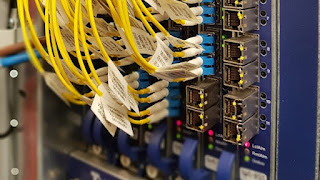Understanding Modern Academic
Computing
As a technology mentor focused on helping new college students, I've observed how the Internet and Web technologies have become fundamental to academic success. The Internet, as Wienclaw (2021) explains, is a global network of interconnected computers that has transformed information sharing and access. Built on top of this foundation, the World Wide Web provides a user-friendly interface that students use daily for navigating and interacting with online content. Whether it is social networks, online learning platforms, or just browsing the web, knowing how to use this tool is especially beneficial in todays day and age.
Historical Evolution and Operation
The evolution from traditional to Internet-based learning reflects
broader changes in computing technology. As Soukup (2024) notes, the Web has
evolved from a simple information-sharing platform to today's complex,
interactive environment. This evolution helps us understand how students can
adapt to and benefit from technological advancements, developing the
flexibility needed to thrive in an ever-changing digital landscape.
Essential Hardware Components
For new college students, understanding the hardware that powers their
online learning is crucial:
- Computers and Mobile Devices: Access points for educational
resources
- Network Hardware: Enables connection to
university systems
- Storage Devices: Maintains local copies of
course materials
- Input/Output Devices: Facilitates interaction with
digital content
These components work together to create the infrastructure necessary for
accessing online learning resources and participating in virtual classrooms.
Programming and Web Technologies
Understanding how web technologies function helps students better utilize
online resources. Vahid and Lysecky (2019) emphasize the importance of
comprehending basic Internet protocols and web technologies for effective
online communication and information sharing. Key concepts include:
- How web browsers interpret and
display content
- How web applications process user
interactions
- How data moves between client and
server
- How different programming
languages work together to create interactive experiences
Application Software in Academic
Context
Modern students rely on various web applications for their studies:
Academic Tools
- Learning management systems
- Online research databases
- Digital libraries
- Citation management software
Collaboration Platforms
- Group project management tools
- Real-time document collaboration
- Video conferencing systems
- Discussion forums
These tools, as highlighted by Vahid and Lysecky (2019), enhance student
learning experiences by improving their ability to work on group projects,
share resources, and engage in peer-to-peer learning.
Database Systems in Education
Understanding database concepts helps students:
- Organize their research materials
- Manage academic resources
- Access online libraries
effectively
- Navigate student information
systems
Network Architecture and Security
For new college students, understanding network concepts is essential
for:
Connectivity
- Accessing campus networks
- Connecting to online resources
- Participating in remote learning
- Sharing academic materials
Security
- Protecting personal information
- Securing academic work
- Maintaining data privacy
- Following institutional security
policies
Practical Applications for Students
The key question remains: "How can new college students best
leverage Internet and Web technologies to enhance their academic performance
and digital literacy?" Based on my research, successful strategies
include:
- Research Skills
- Effective online search
techniques
- Evaluating source credibility
- Managing digital information
- Using academic databases
- Collaboration Tools
- Digital project management
- Online group work
- Remote team coordination
- Resource sharing
- Learning Management
- Organizing digital materials
- Managing online assignments
- Tracking academic progress
- Engaging with digital content
Future Implications
As higher education increasingly integrates online components, students
must prepare for:
- Advanced learning platforms
- New collaboration tools
- Emerging technologies
- Evolving security requirements
Conclusion
Understanding and effectively utilizing Internet and Web technologies is
crucial for today's college students. By mastering these fundamental
technologies, students can better navigate their academic journey and prepare
for future careers in an increasingly digital world. As Vahid and Lysecky
(2019) emphasize, this knowledge provides the foundation for effective online
communication, information sharing, and collaborative learning.
References
Soukup, P. A. (2024). The World Wide Web's First 35 Years. Communication
Research Trends, 43(2), 1-30.
Vahid, F., & Lysecky, S. (2019). Computing technology for all.
zyBooks.
Wienclaw, R. A. (2021). Internet Computing. Salem Press Encyclopedia.



























